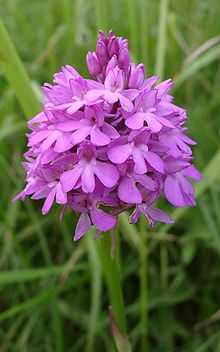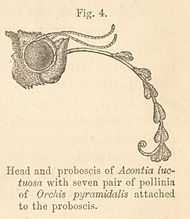Anacamptis pyramidalis
| Anacamptis pyramidalis | |
|---|---|
 | |
| Scientific classification | |
| Kingdom: | Plantae |
| (unranked): | Angiosperms |
| (unranked): | Monocots |
| Order: | Asparagales |
| Family: | Orchidaceae |
| Subfamily: | Orchidoideae |
| Genus: | Anacamptis |
| Species: | A. pyramidalis |
| Binomial name | |
| Anacamptis pyramidalis (L.) Rich. | |
| Synonyms | |
| |
Anacamptis pyramidalis, the pyramidal orchid,[1] is a perennial herbaceous plant belonging to the genus Anacamptis of the family Orchidaceae. The scientific name Anacamptis derives from Greek ανακάμτειν 'anakamptein' meaning 'bend forward', while the Latin name pyramidalis refers to the pyramidal form of the inflorescence.
Description

This hardy plant reaches on average 10–25 centimetres (3.9–9.8 in) of height, with a maximum of 60 centimetres (24 in). The stem is erect and unbranched. The basal leaves are linear-lanceolate with parallel venation, up to 25 centimetres (9.8 in) long, the cauline ones are shorter and barely visible on the stem. The arrangement of hermaphroditic flowers in a compact pyramidal shape is very distinctive and gives the orchid its common name. The colour of the flower varies from pink to purple, or rarely white, and the scent is described as "foxy". The flowers have six tepals, being three small sepals and three petals. Two small petals are on the sides, while the third and lower (labellum) is large and bilobate. At the back of the flower there is a tubular spur of about 1.5 centimetres (0.59 in) long, while the labellum bears two lateral small flaps. The flowering period extends from April through July.
Reproduction
The flowers are pollinated by butterflies and moths. To ensure the fertilization, their morphology is well adapted to the proboscis of Lepidoptera, especially Euphydryas, Melanargia, Melitaea, Pieris and Zygaena species. The mechanism by which its pairs of pollinia attach themselves to an insect's proboscis was discovered by Charles Darwin and described in his book on the Fertilisation of Orchids.[2]
Distribution
This orchid is native to southwestern Eurasia, from western Europe through the Mediterranean region eastwards to Iran. In Germany, it is rare and was declared Orchid of the Year in 1990 to heighten awareness of this plant. This orchid is somewhat common on the Isle of Wight in the South of England, and was designated the county plant in 2008.
Habitat
Anacamptis pyramidalis requires a sunny spot on diverse soils: loamy or clay. It can even grow on very alkaline soil. It can be found on meadows or dry and well exposed slopes, at an altitude of 0–2,000 metres (0–6,562 ft) above sea level.
Gallery
Plants of Anacamptis pyramidalis |
Inflorescences of Anacamptis pyramidalis |
Close-up on inflorescence of Anacamptis pyramidalis |
Close-up on a flower of Anacamptis pyramidalis |
Leaf of Anacamptis pyramidalis |
Varieties
There are some notable varieties, which are sometimes treated as subspecies – and as they seem to be limited to certain regions, this may be correct:
- Anacamptis pyramidalis var. tanayensis (Chenevard) Soó in Keller – Tanay Pyramidal Orchid - Flowers darker and smaller. Fribourg and Valais cantons (Switzerland).
- Anacamptis pyramidalis var. urvilleana (Sommier & Caruana) Kreutz – Maltese Pyramidal Orchid Malta.
- Anacamptis pyramidalis var. sanguinea (Druce) Kreutz – Western Irish Pyramidal Orchid. -Inflorescence rounder, plant smaller overall. County Galway to County Kerry (Ireland)
The variety alba can be found anywhere in the Pyramidal Orchid's range; its flowers are white.
Medicinal uses
The dried and ground tuber gives a fine white powder, called salep. This is a very nutritious sweet starchlike substance. It is used in drinks, cereals and in making bread. It is also used medicinally in diets for children and convalescents.
Culture
The pyramidal orchid was voted the County flower of the Isle of Wight in 2002 following a poll by the wild flora conservation charity Plantlife.[3]
References
- ↑ "BSBI List 2007". Botanical Society of Britain and Ireland. Archived from the original (XLS) on 2015-02-25. Retrieved 2014-10-17.
- ↑ Darwin 1862, pp. 20–24, 37
- ↑ Plantlife website County Flowers page
- Darwin, Charles (1862), On the various contrivances by which British and foreign orchids are fertilised by insects, and on the good effects of intercrossing, London: John Murray, retrieved 2009-07-30
External links
| Wikimedia Commons has media related to Anacamptis pyramidalis. |
- Anacamptis pyramidalis at the Encyclopedia of Life
- Den virtuella floran - Distribution
- Comprehensive profile for Anacamptis pyramidalis from the website MaltaWildPlants.com
- Biolib
